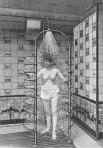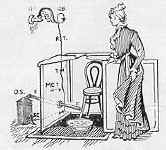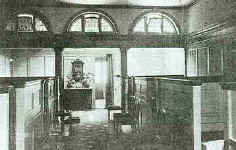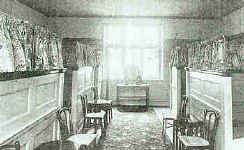6. Attitudes to privacy, nudity, and exercise

Not everyone thought that prices alone were responsible for there being fewer women bathers than men. ‘Penelope’ suggested in the Rochdale Times that,
there is something contrary to feminine instinct in the gregarious nature of a public Turkish bath. We like such things best at home, or at all events at some bathing establishment where we may be residing for a time…33
Penelope’s solution was the portable Turkish bath which was, she confirmed, easily assembled at home.
Three general advertisements for portable baths
Connect to the gas
Multi-tasking
Robert Owen Allsop, the only architect or engineer—he was both—to write extensively on the bath, understood that many British women, unlike their French counterparts at Aix-les-bains, preferred not to get undressed or take showers in communal areas.

‘In ladies' baths,’ he wrote, ‘more privacy must be observed. Each lady bather should have a private dressing and reposing room, even if only formed by dwarf wooden partitions,’34 and ‘private shampooing recesses’ should be formed with partitions of wood and ‘obscure glass.’35
Nottingham: men's cooling-room
Nottingham: women's cooling-room
But many women probably did swim naked in the plunge pools, just as the men did. For although there are numerous references to ‘full loose robes,’36 or ‘a kind of toga…descending from the shoulders’,37 no other garments are ever mentioned, however detailed the description of the bathing process.
With so few known personal accounts of women's experience of the Victorian Turkish bath, we are fortunate that excerpts from The diaries of Maud Berkeley have been adapted and published by Flora Fraser. In the entry for 30 March 1892, Maud includes a visit with two of her friends to an unidentified Turkish bath in London. This is accompanied by drawings which clearly show how the three bathers were draped in towels. Maud's delightful drawings, and the brief entry itself, indicates that some young Victorians also had a lively sense of humour.59
This lack of women's accounts of the bath was probably responsible for Allsop's less happy suggestion that ‘a plain, circular bath with steps around’ would be appropriate because in ‘ladies’ baths… the true dive does not pertain.38 Here, he seems to shows a lack of awareness of the active female membership of the burgeoning mid-1880s swimming clubs.39
The typical male view was still that women should never undertake physical exercise or exert themselves in any way. As the pseudonymous author of a booklet espousing the bath declared in 1858, ‘to ladies, to invalids, and men of business, whose sedentary occupations preclude the possibility of healthful exercise,’ the Turkish bath was ‘an inestimable boon.’40
Proprietors reinforced such attitudes, unimaginatively parroting each other. In 1895, Joseph Constantine reprinted advice written several years earlier ‘by a medical man’:
Ladies need these baths even more than gentlemen, and are more benefited by them, owing to their being more confined to the house and not getting so much exercise in the open air as men do.41
Incredibly, this was reprinted almost word for word nearly 80 years after it was first written, in a booklet published by Derby Council in 1964—the Swinging Sixties:
Ladies need these baths even more than gentlemen, and are more benefited by them, owing to their being usually more confined indoors, having less exercise, etc.42







